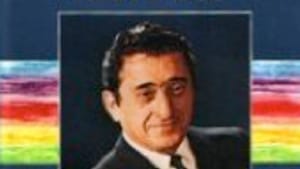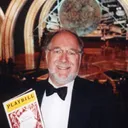Stay in the Loop
BSR publishes on a weekly schedule, with an email newsletter every Wednesday and Thursday morning. There’s no paywall, and subscribing is always free.
A lesson from the Bluebird (with a little help from Jan Peerce)
EgoPo's "Bluebird' (2nd review)

Our editor, Dan Rottenberg, recently asked those of us who write about theater to recommend new names in order to update his 2004 "subjective guide" to "the region's 12 best theater companies." I chose (among others) EgoPo. And the main reason for my choice was evident in that company's recent production of Maurice Maeterlinck's Bluebird.
What other company would tackle such a play? And what other company could lavish so much time on learning and rehearsing such a daunting work? Its language and its style are alien to most audiences and to almost all of today's actors.
Maeterlinck was a French-speaking Belgian who wrote a series of symbolist plays characterized by fatalism and mysticism, most importantly Pelleas et Melisande and L'Oiseau bleu (The Blue Bird.) He tried to relate absolute truths through metaphorical means, endowing objects and feelings with symbolic meaning. Thus, in The Blue Bird, we see Joy, Luxury, Sugar, Light and other ideas and objects as characters in the play. Animals and inanimate objects accompany children on a quest through various lands of enchantment until fulfillment is found right at home among one's loved ones.
Haunting but hardly original
Maeterlinck's moral— that you can find riches in your own back yard— echoed the inspirational "Acres of Diamonds" sermon that Temple University's founder Russell Conwell delivered more than 6,000 times around the world, beginning in 1890. The lesson was repeated in L. Frank Baum's Wonderful Wizard of Oz in 1900, before Maeterlinck wrote his version in 1908. So this is hardly an original concept. But Maeterlinck's version is the most haunting.
I refer you to Jim Rutter's review for a detailed exposition of the play. The story is a bit preachy, and I can understand that some may consider it a museum piece. Maeterlinck's style of drama is hard to relate to, and so is the belief that human beings are controlled and propelled by fate, as in the scene where unborn babies await assignment to be born. So director Lane Savadove deserves great credit for editing the play (as well as re-titling it with the one-word Bluebird) and giving it new life.
An awesome undertaking
The large cast of young people had to be trained and coached in this unique milieu; performance of a musical score by George Crumb had to be integrated with the drama; Jamie Grace-Duff executed spectacular costumes; and the Mandell Theater at Drexel University was rearranged to approximate a forest (hundreds of tree limbs and branches filled the side sections of the auditorium and parts of the stage).
Savadove and his staff created many vivid stage tableaux, affecting emotions and some real comedy. Standouts among the cast were Sarah Schol as fairy and vocalist, Megan Hoke as Cat, Doug Greene as Dog, and Rob Neddoff, who was amazingly entertaining with his quick changes as a series of expendable luxuries we all recognize. Crumb's score was performed by members of Orchestra 2001 in the timeless, flexible, breathing manner that the composer requested.
The blue bird of the title often is thought of as "the bluebird of happiness," even once in the play's script. But it becomes apparent that to Maeterlinck life's ultimate goal was neither happiness nor joy but something more evanescent and actually more satisfying: comfort and understanding.
Inspiration for a song
Still, because of the widespread public perception, a song called "Bluebird of Happiness" was written by the Hungarian-American composer Sandor Harmati, with words by Edward Heyman and Harry Parr Davies. It was introduced at the new Radio City Music Hall in New York by the theater's tenor soloist, Jan Peerce. The song had a good, schmaltzy melody but above all it connected with audiences because of the sentiment in its lyric:
"You will find greater peace of mind
Knowing there's a Bluebird of Happiness.
And when he sings to you,
Though you're deep in blue,
You will see a ray of light creep through,
And so remember this, life is no abyss,
Somewhere there's a Bluebird of Happiness."
Teenagers listened for it
Subsequently Peerce recorded the song anonymously for license to radio stations across the country. WIP in Philadelphia began using it regularly on its overnight show, "The Dawn Patrol." Teenagers coming home from dates in the 1940s learned to tune in just to hear Peerce sing that song. By 1962, when I interviewed Peerce for a radio show, he was a leading tenor at the Metropolitan Opera. On that occasion I asked him if he sometimes grew tired or annoyed by requests to sing that corny old song.
"Never," he replied. "The reason I sing is to communicate with people's feelings, to touch them. That song has something real to teach people. I actually have received letters from people who said they were going to commit suicide until they heard that song, and it turned them around."
What I learned from Peerce and from the EgoPo production alike is that there are still people who need the message behind the Bluebird"“ the song as well as the play. â—†
To read another review by Jim Rutter, click here.
To read a response, click here.
What other company would tackle such a play? And what other company could lavish so much time on learning and rehearsing such a daunting work? Its language and its style are alien to most audiences and to almost all of today's actors.
Maeterlinck was a French-speaking Belgian who wrote a series of symbolist plays characterized by fatalism and mysticism, most importantly Pelleas et Melisande and L'Oiseau bleu (The Blue Bird.) He tried to relate absolute truths through metaphorical means, endowing objects and feelings with symbolic meaning. Thus, in The Blue Bird, we see Joy, Luxury, Sugar, Light and other ideas and objects as characters in the play. Animals and inanimate objects accompany children on a quest through various lands of enchantment until fulfillment is found right at home among one's loved ones.
Haunting but hardly original
Maeterlinck's moral— that you can find riches in your own back yard— echoed the inspirational "Acres of Diamonds" sermon that Temple University's founder Russell Conwell delivered more than 6,000 times around the world, beginning in 1890. The lesson was repeated in L. Frank Baum's Wonderful Wizard of Oz in 1900, before Maeterlinck wrote his version in 1908. So this is hardly an original concept. But Maeterlinck's version is the most haunting.
I refer you to Jim Rutter's review for a detailed exposition of the play. The story is a bit preachy, and I can understand that some may consider it a museum piece. Maeterlinck's style of drama is hard to relate to, and so is the belief that human beings are controlled and propelled by fate, as in the scene where unborn babies await assignment to be born. So director Lane Savadove deserves great credit for editing the play (as well as re-titling it with the one-word Bluebird) and giving it new life.
An awesome undertaking
The large cast of young people had to be trained and coached in this unique milieu; performance of a musical score by George Crumb had to be integrated with the drama; Jamie Grace-Duff executed spectacular costumes; and the Mandell Theater at Drexel University was rearranged to approximate a forest (hundreds of tree limbs and branches filled the side sections of the auditorium and parts of the stage).
Savadove and his staff created many vivid stage tableaux, affecting emotions and some real comedy. Standouts among the cast were Sarah Schol as fairy and vocalist, Megan Hoke as Cat, Doug Greene as Dog, and Rob Neddoff, who was amazingly entertaining with his quick changes as a series of expendable luxuries we all recognize. Crumb's score was performed by members of Orchestra 2001 in the timeless, flexible, breathing manner that the composer requested.
The blue bird of the title often is thought of as "the bluebird of happiness," even once in the play's script. But it becomes apparent that to Maeterlinck life's ultimate goal was neither happiness nor joy but something more evanescent and actually more satisfying: comfort and understanding.
Inspiration for a song
Still, because of the widespread public perception, a song called "Bluebird of Happiness" was written by the Hungarian-American composer Sandor Harmati, with words by Edward Heyman and Harry Parr Davies. It was introduced at the new Radio City Music Hall in New York by the theater's tenor soloist, Jan Peerce. The song had a good, schmaltzy melody but above all it connected with audiences because of the sentiment in its lyric:
"You will find greater peace of mind
Knowing there's a Bluebird of Happiness.
And when he sings to you,
Though you're deep in blue,
You will see a ray of light creep through,
And so remember this, life is no abyss,
Somewhere there's a Bluebird of Happiness."
Teenagers listened for it
Subsequently Peerce recorded the song anonymously for license to radio stations across the country. WIP in Philadelphia began using it regularly on its overnight show, "The Dawn Patrol." Teenagers coming home from dates in the 1940s learned to tune in just to hear Peerce sing that song. By 1962, when I interviewed Peerce for a radio show, he was a leading tenor at the Metropolitan Opera. On that occasion I asked him if he sometimes grew tired or annoyed by requests to sing that corny old song.
"Never," he replied. "The reason I sing is to communicate with people's feelings, to touch them. That song has something real to teach people. I actually have received letters from people who said they were going to commit suicide until they heard that song, and it turned them around."
What I learned from Peerce and from the EgoPo production alike is that there are still people who need the message behind the Bluebird"“ the song as well as the play. â—†
To read another review by Jim Rutter, click here.
To read a response, click here.
What, When, Where
Bluebird. By Maurice Maeterlinck, adapted by Molly Rice; directed by Lane Savadove; music by Orchestra 2001. EgoPo production through May 10, 2009 at Mandell Theatre, 33rd and Chestnut St. (800) 595-4849 or www.egopo.org.
Sign up for our newsletter
All of the week's new articles, all in one place. Sign up for the free weekly BSR newsletters, and don't miss a conversation.

 Steve Cohen
Steve Cohen